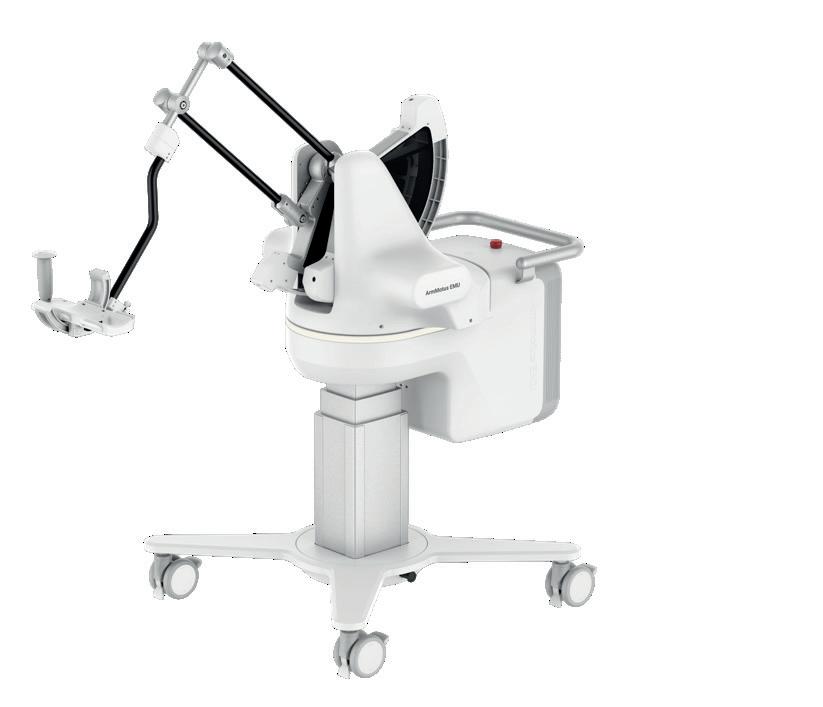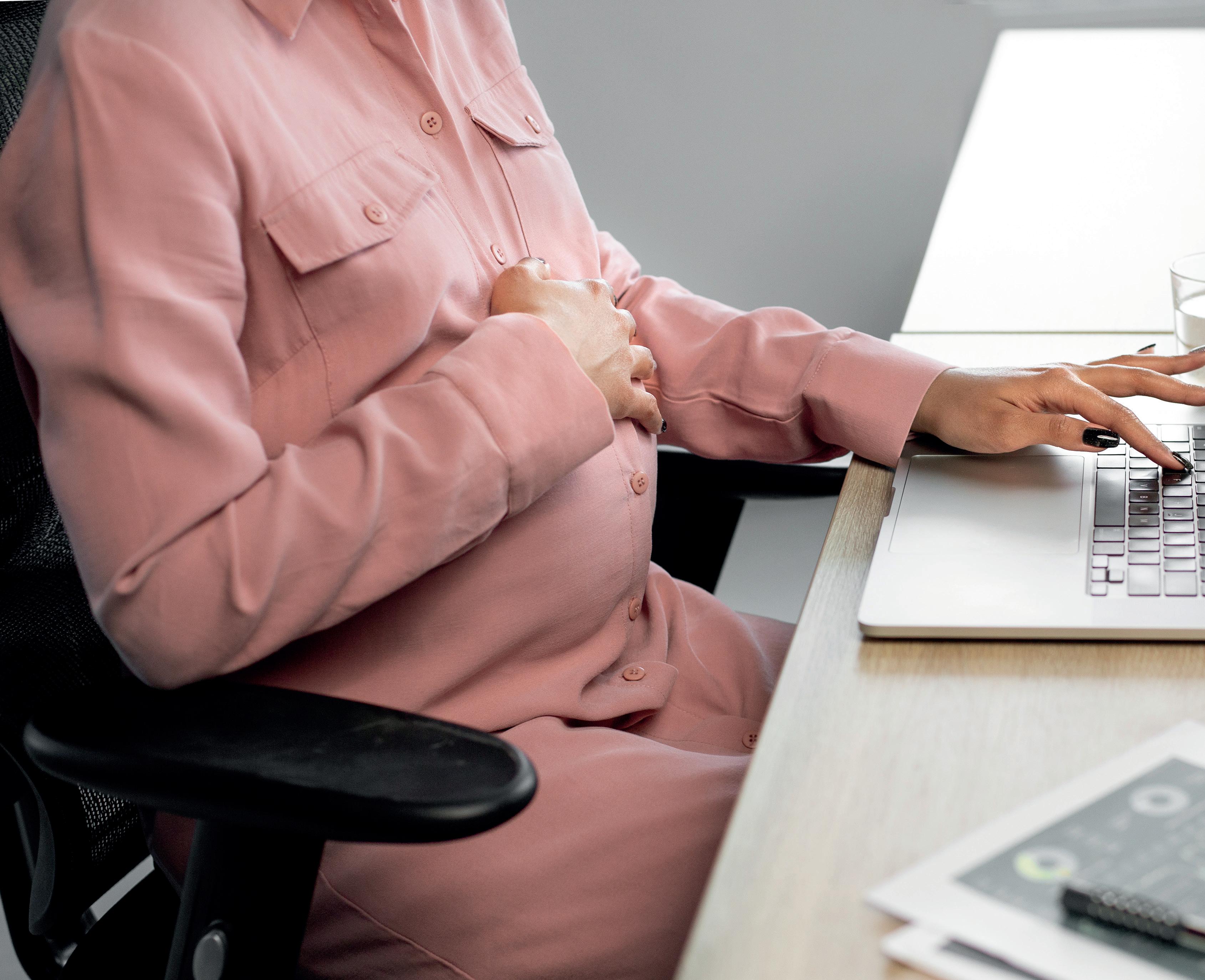
8 minute read
ROBOTIC RISE
ArmMotus ™ EMU
next-gen rehabtech changing the game for patients
Advertisement
Through the launch of the robot hailed as having the potential to change neuro-rehab as we know it, Fourier Intelligence is stepping up options for patients in their recovery further still. NR Times learns more about its pioneering device
Through the use of the ArmMotus™ EMU, neuro-rehab is being redefined for people around the world who are living with brain injury, spinal cord injury and neurological conditions, with its revolutionary approach to recovery helping to change lives. The ArmMotus™ EMU - the world’s first 3D back-drivable upper limb rehabilitation robot - is designed to support upper limb rehabilitation, and through its ability to engage patients in games, created especially to advance their recovery potential, it can chart their progress like never before. In a unique approach to rehab robotics, the ArmMotus™ EMU - created by global rehabtech leader Fourier Intelligence - used a games-based approach, combined with artificial intelligence, to precisely measure every movement trajectory, strength, cognitive ability, ROM and motor control ability, and then generate a report after each training period.
This gives unparalleled insight for the therapist into the progress and current ability of the patient, enabling them to deliver more bespoke rehabilitation and a more personalised approach. Unveiled last year, the ArmMotus™ EMU has become a highly significant introduction into the rehab robotics market, with the device being hailed as helping to redefine the future. The upper limb device has also since won many awards – the iF Award, the Red Dot Design Award, the Medical Design Excellence Awards and the most recent, the Good Design Award. “Current neuro-rehabilitation models primarily rely on extended hospital stays or regular therapy sessions which require close physical interactions between rehab professionals and patients,” said Zen Koh, Founder and global chief executive officer of Fourier Intelligence. “The COVID-19 pandemic situation has challenged this model and as a result, many neurological patients are not receiving sufficient therapy. There is an urgent need to rethink conventional neuro-rehabilitation therapy. “The new ArmMotus™ EMU provides that solution. Equipped with clinical intelligence, it provides personalised therapy, technologybased solutions, coaching capabilities and remote monitoring.

“The implementation of fun functional games with embedded artificial intelligence also provides clinically motivating therapy to patients as well as giving caregivers and healthcare practitioners confidence.” Users of the ArmMotus™ EMU speak of its ease of use and the joy of using its gamified approach - which uses a range of games including table tennis, cooking, and fishing, to simulate activities of daily living - and is a hugely different approach to the traditional rehab many people have experienced in the past. One patient, who is recovering from a spinal cord injury, said: “I really like that it helps me get my arms away from my body and I get a lot of exercise with it. “It makes it fun in a way because you’re playing games and you don’t realise how much work you’re doing. “But then afterwards you definitely feel like you’ve been doing something, you feel you’ve been working your arms. It’s been very useful for me; it has helped a lot.” The ArmMotus™ EMU, jointly built by Fourier Intelligence and the University of Melbourne Robotics Laboratory, took six years to bring to fruition and was led by Professor Denny Oetomo. The robot is the product of a hugely successful collaboration, one of many Fourier Intelligence is creating around the world with key sites in neuro-rehab and academia, to help pioneer the future of intelligent solutions which have the power to improve patients’ lives. Bringing together the huge tech capability of Fourier Intelligence’s team with the academic excellence of Professor Oetomo and his team, the launch of the ArmMotus™ EMU has been welcomed around the world. Covering the whole continuum of rehabilitation, it makes use of Fourier Intelligence’s sector-leading force feedback technology, which recreates the touch of a therapist’s hand and supports the user to adjust the assistance or resistance according to their needs. It also supports easy training setup in sitting and standing positions, as well as accommodating different training arms. The device integrates different scenarios in the game so that users can train on strength, motor control and joint ROM in one training session, making the whole rehabilitation process more efficient. Through its ability to deliver real-time analysis and personalised feedback and reporting, a therapist can tailor a targeted therapy according to the patient’s training outcomes and needs, maximising the potential of each session. Its levels of engagement through gamesbased rehabilitation is also helping to drive patient outcomes through better levels of participation and effort.
7 Tips to Help Manage Maternity Leave

Cecily Lalloo, Managing Director of Embrace HR, a consultancy specialising in HR support to Deputies and Case Managers, says that maternity leave can be a tricky time; both for the expectant mother dealing with pregnancy, and for the employer responsible for managing the employee.
The scenario
The recruitment campaign has been on-going for a while. The ideal candidate, Wilhelmina, is offered the job, and accepts, and a start date is agreed. An offer is sent to her along with all the necessary requirements for checks such as DBS, drivers’ licence, pre-employment health questionnaire. The start date is arranged, and a contract is drafted and sent, as well as mandatory training information. Wilhelmina powers through her training and probationary period, she settles into the role and three months later she informs her manager that she is pregnant. This may be an inconvenience to the organisation and the team. However, it is a time of celebration for Wilhelmina as it is her first pregnancy. She is anxious and excited. As an employer it is important to acknowledge how she feels and to support her as much as possible while she continues to do her job.


Here are our 7 Tips
1. Breathe – when you hear the news!
2. Don’t make comments about the short length of time she has been with you or how the training has just finished, and it is inconvenient.
3. Congratulate Wilhelmina, ask how she wants her news to be conveyed to colleagues. She may not want anyone to know just yet. She may want to convey the news herself. If her work requires lifting and handling, she may need to advise colleagues earlier rather than later.
4. Advise her that she must notify you formally in order to benefit from maternity leave and pay. It is helpful to send her information so that she has a guide of what to notify and by when. 5. Let your HR adviser or manager know about the pregnancy. HR will have a maternity pack with useful information for the employee and reminders of the process and important dates.
6. A risk assessment for pregnant mothers must be undertaken. This is best done by someone who works closely with Wilhelmina. The risk assessment should be reviewed periodically throughout the pregnancy. When Wilhelmina returns to work, a new mother's risk assessment should be undertaken.
7. Discussions about holidays, time off for antenatal visits and maternity leave dates need to be diarised and discussed, and cover for absences arranged.
What you should know
The same statutory obligations apply to managing maternity leave whether the organisation is small or large. Whether there are 2 workers or 2,000 workers. Often there is more than one person who is pregnant or on maternity leave at the same time. It is important to manage the process carefully. There will be many conversations as changes take place, not least if baby arrives early and your worker is ill. Speak regularly with your pregnant mother so that the management of her time at work and the absences are covered as well as possible. Remember that if you decide on a temporary worker to cover whilst she is away, that person must not be offered the role permanently. If there are any changes to her job role, communicate with her. Ensure that you arrange how your employee would like to be communicated with whilst on maternity leave. Women on maternity leave can often feel isolated from what is happening at work so it is important to make sure they still feel part of the team. There is a balance to be struck, let her know what you will contact her about and that you or your HR person can be contacted at any time. Have a discussion before your worker starts their maternity leave about how much contact they would like, as preferences will vary. Send news updates and invitations to social events and make sure you keep them informed of any important team decisions. If you want to ask them to attend work or carry out some trainings whilst on maternity leave, arrange this via Keeping In Touch (KIT) days if they are interested. Pregnancy should be a happy time for your workers who will be going through many changes. However, it is a normal life event, and most people can work long into their pregnancy with the right management and adjustments. Adjustments that may be necessary for shift workers are different working times and refresher training in lifting and handling or remove some elements of the job and replace with others. Occasionally, if adjustments cannot be made, suspension may be necessary. Speak with HR before taking this decision. Provided you understand the minimum legal requirements, the best way to show support as an employer is through excellent communication. The more your employee feels they can be open about their preferences and intentions, the better placed you will be to respond. It is important that the maternity leave process is started as soon as notification of a pregnancy is received.
Embrace HR will be happy to discuss any of your maternity leave and pay queries, or any family leave queries you may have. Contact us on 01296 761 288 or email admin@embracehr.co.uk.




